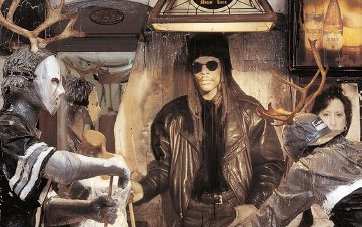Kienholz
dal 5/10/2005 al 9/11/2005
Segnalato da
5/10/2005
Kienholz
Haunch of Venison Yard, London
From the late 1950s the artists made installations before they became a feature of contemporary art, and conceptual works before the term became a movement. Their sculptures transformed Pop Art, reassembling discarded consumer objects into surreal and discordant forms that were designed to shock and disgust the viewer.

Works by Edward Kienholz and Nancy Reddin Kienholz
Kienholz brings together a representative selection of key works by
American artists Edward Kienholz (1927-1994) and Nancy Reddin Kienholz
(born 1943).
From the late 1950s Kienholz made installations before they
became a feature of contemporary art, and conceptual works before the term
became a movement. His sculptures transformed Pop Art, reassembling
discarded consumer objects into surreal and discordant forms that were
designed to shock and disgust the viewer, exposing them to the nightmare
underbelly of the American dream.
Kienholz has had a huge influence on
future generations of artists, and his work can be read in relation to the
theatricality and grubby hand-made seediness of the YBA installation artists
who featured in Saatchi’s Sensation show. This is the first exhibition of work
by Kienholz in London since 11 Kienholz Tableaux at the ICA in 1971, and
the first showing in London of solo work by Nancy Reddin Kienholz.
Kienholz presents four groups of works.
In his Concept Tableaux, made in
the 1960s, Kienholz typed details of proposed works on a piece of paper,
each accompanied by a brass plaque bearing the work’s title, that would be
realised if a buyer came up with the cash. These works are some of the
earliest examples of what came to be known as Conceptual art, the
movement that dominates contemporary art. The War Room presents a
group of works made by Ed and Nancy during the 1980s and early 1990s
that question the way we commemorate war, including Soldier X. The
Kienholz Women is a group of assemblage sculptures from the 1970s and
1980s, that explore the formation of the American male psyche. The Bronze
Pinball Machine with Woman Affixed Also, juxtaposes a working Playboy
Pinball machine from the 1970s, with the cast bronze spread legs of a young
woman. Finally, the exhibition includes a group of twenty watercolours from
the 1990s, including $495, that present a notional fixed cash value for the
work, creating an alternative currency that is more valuable than that printed
by the US Government.
Kienholz was a farmer’s boy of Swiss ancestry from Washington State, a
self-taught artist, who made a living as an odd-job man in LA in the 1950s.
Amongst many other jobs he decorated bars in Las Vegas and opened the
Ferus gallery with Walter Hopps, a shortlived but influential LA gallery.
Kienholz had his first solo exhibition in 1955 and in 1966 the LA County
Museum held an important retrospective of the artist’s work that caused
widespread controversy and outrage, establishing his position as a leading
artist of his generation. Kienholz moved to Berlin in 1972 when he married
Nancy Reddin. They worked together until Ed’s death in 1994, shortly before
their first joint retrospective, at the Whitney Museum of American Art in
1996. Nancy Reddin Kienholz lives and works in Hope, Idaho; Houston,
Texas and Berlin, Germany. The artists’ work can be found in major
collections in America and across continental Europe including the Centre
Pompidou, Paris; the Museum of Modern Art, New York and the Stedelijk,
Amsterdam.
Kienholz is accompanied by a fully illustrated exhibition catalogue with
essays by art historians, Marco Livingstone and Craig Burnett. A
retrospective of Kienholz work, including works from the Haunch of Venison
exhibition, travels to the Museum of Contemporary Art, Sydney from the 16
December 2005 – 5 March 2006. Tate Modern is screening two 1960s
documentaries about Ed Kienholz’s work, The Story of an Artist and
Kienholz on Exhibit , introduced by Nancy Reddin Kienholz and Ed Allington
on Friday 7 October.
Press View: October 6, 10.30 – 12.00
Haunch of Venison
6 Haunch of Venison Yard - London



